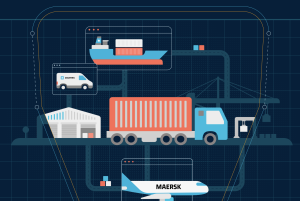Today’s supply chains across all industries are becoming significantly more complex. Suppliers, distributors and retailers are faced with the combined challenges of global sourcing and fulfilment, shorter product life cycles, increasing amounts of legislation, the dynamics of multi‐channel retailing, the speed of technological advances and now, the most challenging economic circumstances in a lifetime.
These disruptive trends are creating significant opportunities, but they are challenging companies to think about the ways in which they manage their businesses and the approach they take to organising their supply chains, said Steve Smith, Senior Vice President Europe, Middle East and Africa of Manhattan Associates, in a recent presentation.
“Faced with this increased level of complexity, industry leaders have begun to move away from just managing their supply chains and are now making strides to reduce supply chain complexity by adopting a more aggressive approach to optimise supply chain performance. This change represents more than a new choice of words – optimising requires a more comprehensive and effective approach that looks at the supply chain and dealing with (increasing) supply chain complexity in an altogether new way.
1. Banish the unintended consequence
“Supply chain management relies on improving the performance of separate parts of the supply chain, often with independent and unlinked systems, making the warehouse more productive, for instance, or driving down transportation costs. This pinpoint focus has repercussions throughout the enterprise, not all of them good.
“When companies reduce inventory by increasing the number and frequency of shipments, for example, they typically increase transportation costs; when they increase picking efficiency in the warehouse, they often drive up staging and loading costs. To truly optimise, companies must be able to run what‐if scenarios that tell them what the full impact of proposed changes would be across the enterprise, so they can see where costs may go up as well as how a specific initiative will improve performance in the targeted area.
2. Expand who’s in the supply chain
“Companies in the vanguard of supply chain optimisation are taking a broader, “supply chain ecosystem” view. They monitor not just their suppliers’ performance, but the efficiency and responsiveness of their suppliers’ suppliers – so they’re not caught short on inventory because a supplier’s supplier has experienced quality problems. They monitor trends to predict the future behaviour and expectations of their customers and the emerging demands of their customers’ customers. With advanced monitoring, they can predict changes in order volume earlier in the process and deliver those ‘must‐ have’ Easter gifts while they’re still hot – and it’s still Easter.
3. See the big picture and obliterate the small processes
“One of the most significant innovations wrought by supply chain management involved pushing processes back to an earlier stage, like asking suppliers to pack orders to be store ready. Optimising a supply chain may mean going even further and skipping some steps entirely. Suppliers can ship store (ready cases directly to customers), for instance, as a number of fast‐growing consumer goods companies now do. By looking at all the processes in the supply chain holistically, managers can minimise complexity and reduce response times and costs without experiencing unwanted disruptions elsewhere in the network.
“Sometimes improvement comes from knowing what hasn’t happened. Clearly, managers need to know what’s on hand and where, but increasingly they want to know what critical events have not occurred as scheduled. For instance, if a storm or flood keeps a shipment from leaving on time, a manager in a company with an optimised supply chain would be alerted in time to deploy alternative sources. If other options are not readily available, the ideal system would automatically change order promise dates, letting everyone in the network know about the changes immediately so they, too, can develop alternatives.
4. Link-in planning, but don’t lock in to plans
“The old maxim says that those who fail to plan, plan to fail. In today’s economy sticking to a plan that doesn’t reflect the most current information can be nearly as deadly. Truly optimised, competitive systems depend on flexible plans and processes that change as new information about market conditions, supplies, product performance and other factors become available. In the supply chain ecosystem as in its natural counterpart, things constantly evolve – and in competitive markets, it’s change or die.
“In an optimised supply chain, planning and execution are closely coupled and interdependent. For example, a retailer may generate a purchase order for a product based on projected demand at the store level plus anticipated Web and catalogue sales. Once the product has shipped from the manufacturer, however, actual sales may show that demand in certain stores is substantially below forecast, while Web sales are outpacing their projections.
“A sophisticated planning system will receive the sales information as it’s reported, and automatically reallocate the incoming inventory to increase the stock available for Web customers and send less to underperforming stores. Ideally, the system would also determine whether product would go to a distribution centre or directly to customers or stores, depending on the demand and promise dates. This flexibility throughout the planning and delivery cycles enables the company to minimise its inventory, maximise sales and increase customer satisfaction.


























